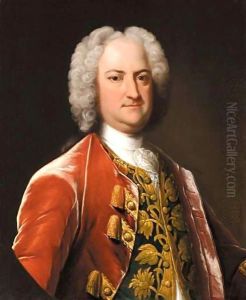Vanloo, Jean Baptiste Paintings
Jean-Baptiste van Loo was a French subject painter and portraitist who was born on January 14, 1684, in Aix-en-Provence, France. He was part of the Van Loo family of painters, which included his father, Louis-Abraham van Loo, a minor painter, and his more famous brother Charles-André van Loo, also known as Carle van Loo. Jean-Baptiste's early training was under the guidance of his father and later his brother.
Van Loo's career began in earnest when he moved to Rome in 1712, where he studied under Benedetto Luti and the sculptor Pierre Legros. During his time in Rome, he was influenced by the works of the Baroque masters, which would have a lasting impact on his style. In 1717, he was awarded the Prix de Rome, which further established his reputation as a talented artist.
After several years in Italy, van Loo moved to Paris, where he gained membership in the Royal Academy of Painting and Sculpture in 1720. His work caught the attention of the regent, Philippe d'Orléans, and other members of the French aristocracy. As a result, he received numerous commissions for portraits and historical scenes. Jean-Baptiste's success in Paris led him to establish his own studio, which became a center for artistic training.
Jean-Baptiste van Loo's portraits were especially sought after. He was known for his ability to capture the elegance and sophistication of his subjects, often portraying them in opulent settings with a deft use of color and texture. His style was characterized by a harmonious blend of realism and idealization, typical of the Rococo period.
In 1737, van Loo was invited to England by Lord Chesterfield. His time in England was productive, and he painted portraits of many important figures, including members of the royal family. However, his stay in England was short-lived due to a severe illness, and he returned to France in 1742.
Jean-Baptiste van Loo continued to work and receive commissions upon his return to France. He was praised for his work during his lifetime and played a significant role in European art circles. He passed away on December 19, 1745, in Aix-en-Provence. Today, his works are part of several museum collections around the world, including the Louvre in Paris and the National Portrait Gallery in London.

